HUMANITARIAN SIGNIFICANCE OF “LUGAW” OR “PORRIDGE” AS VITAL ESSENTIAL PHILIPPINE STAPLE FOOD HISTORICALLY AND POLITICALLY UNDER PANDEMIC CRISIS

By Domingo P. Herras
Manila
November 24, 2021
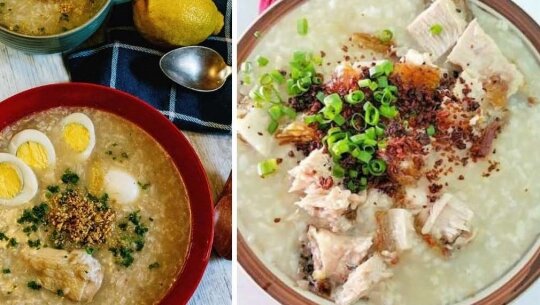 Left photo: plain special lugaw with chicken and egg; Right photo:Lutong bahay lugaw
Left photo: plain special lugaw with chicken and egg; Right photo:Lutong bahay lugaw
MANILA, Philippines – Rice porridge or “lugaw” will always be the Filipino’s comfort food, thus it is considered and essential staple food. It is also considered a symbol of Philippine’s rich culture. According to the National Commission on Culture and Arts “lugaw” is usually made for children and for those who are sick that is why it is said to be a food “cooked with love”. The National Quencenntenial Committee (NQC), on the other hand, regarded the local “rice porridge” dish as “one of the earliest documented food for our ancestors.”
Lugaw or “rice porridge” is made from cooked lutinous rice and flavored with fermented fish sauce (patis) or plain salt. It is usually served at “carenderias” or in downtown “restaurants” serving with hard boiled egg, or with sliced fried pork or chicken or fried tofu (tokwa at baboy), sprinkled with fresh calamansi juice, black pepper, spring onions, fried and toasted browny garlics, and a mixture of other ingredients of your personal choice and cravings.
In a Facebook post, NQC said that based on the 1613 Vocabulario de la Lengua Tagala by Fr. Pedro de San Buenaventura, lugaw is defined as “rice mixed with milk or water or of both (porridge).” Lugaw can be paired or augmented with numerous other dishes and ingredients.
The earliest reference as to when was “porridge” or “lugaw” was invented can be traced back to the Chinese Zhou dynasty (circa 1000 BCE). It is also mentioned in the Book of Rites and Piny’s account of India circa 77 CE.
World War II Humanitarian food for survival “Lugaw” and “Dilis”
During World War II, the Philippines was historically well known as the “Pearl of the Orient”, bore witness to the courage and sacrifices of the U.S. Forces and Filipino fighters fighting side-by-side during the “Battle of Manila” and the “Liberation of Santo Tomas Internment Camp”. During the war the University of Santo Tomas was converterd by the Japanese Government as an internment camp for more than 3,000 foreign civilians who were mostly Americans.
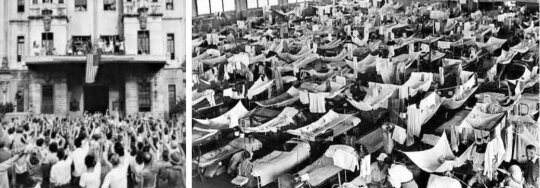 Left photo: Some 100 Internees at Internment Camp cheers during the hoisting of the American Flag after their release from prison in Feb. 5, 1945.; Right photo: Living quarters of Internees at Santo Tomas Internment Camp during World War II in Manila.
Left photo: Some 100 Internees at Internment Camp cheers during the hoisting of the American Flag after their release from prison in Feb. 5, 1945.; Right photo: Living quarters of Internees at Santo Tomas Internment Camp during World War II in Manila.
The University have two campuses during the war which the Japanese had converted, from 1942-1945, the Sampaloc campus became the largest internment camp that can accommodate more casualty patients, staff and internment camp Internees.
World War II American surviving Internee Leslie Ann Murray at the UST Internment Camp in a U.S. Embassy in the Philippines short film documentary, entitled: @AlliesForFreedom: Battle of Manila and Liberation of the Santo Tomas Internment Camp, said in her documentary statement, “When we (Internees) first went in at the UST Internment Camp, in the beginning we were better-fed and as the war got difficult for the Japanese it was the Americans who were on the winning side that the Japanese took it out on the prisoners by cutting the food. We really basically had “lugaw” and “dilis” as our foods to feed our hunger and just to survive during the war, Murray said.
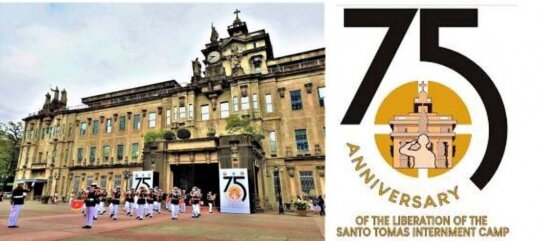 The UST Core of Officers and Cadets Band during the opening ceremonies commemorating the 75th Anniversary of the Liberation of UST Internment Camp.
The UST Core of Officers and Cadets Band during the opening ceremonies commemorating the 75th Anniversary of the Liberation of UST Internment Camp.
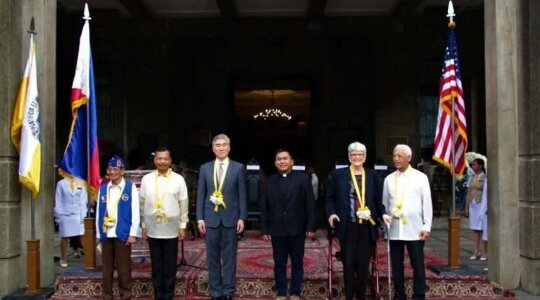 (In photo) US Ambassador to the Philippines Sung Y. Kim (3rd from L) was the Guest Speaker and Surviving Internee Leslie Ann Murray (2nd from R) was also Speaker during the Commemoration.
(In photo) US Ambassador to the Philippines Sung Y. Kim (3rd from L) was the Guest Speaker and Surviving Internee Leslie Ann Murray (2nd from R) was also Speaker during the Commemoration.
Ms. Leslie Ann Murray, who had lived in the Philippines for several years, was among the Speakers during the 75th Anniversary Commemoration of the University of Santo Tomas prison Camp.
Lugaw as Humanitarian and Political Symbol
Vice-President Leni Robredo, a staunch dynamic political leader of the opposition’s political camp, in her pioneering effort with the support of the Filipino mass-based “grassroots” and the marginal communities throughout the country, had successfully initiated the use of “lugaw” in all her events and political activities as their answer and response to pro-Duterte Internet and other social media’s Trolls tagging her in their posts as “Leni Lugaw” or “Lugaw Queen”. This prejorative tag on Vice President Robredo was spurred by her 2016 Election campaigns resorting to the selling of porridge (lugaw) to raise funds for her candidacy campaign for the Vice-Presidential position. After Vice-Pres. Robredo’s triumphant victory in winning the 2016 elections,
her detractors had been continuously using the tag even as of this writing, and the Vice-President’s camp have been responding continuously and serving lugaw compassionately in a humanitarian way in all her current political activities, campaigns, events and other undertakings.
 Left photo:VP Leni-Robredo cooking his best recipe of her essential lugaw as guest chef during tv blog demonstration.; Right photo:VP Robredo with Angat Buhay's staff distributes lugaw in Batangas and Cavite.
Left photo:VP Leni-Robredo cooking his best recipe of her essential lugaw as guest chef during tv blog demonstration.; Right photo:VP Robredo with Angat Buhay's staff distributes lugaw in Batangas and Cavite.
The buzz around the phrase “lugaw is essential” to support a delivery rider blocked by quarantine official reemerged among Filipino social media users. Vice-President Leni Robredo shared a spicy version of the local “porridge” was her lunch while on duty for her Office’s “Bayanihan E-Konsulta Initiative.”
ECQ Pandemic Lockdown “Lugaw” Controversy
During the the early start of the implementation of Pandemic (Enhanced Community Quarantine) - ECQ crisis lockdowns, a controversial issue that went viral in the social media pointing-out as to whether “lugaw” is an essential food or not. Phez Raymundo speaks on Facebook about the issue of “lugaw” controversy that ignited ambivalent netizen’s reactions when the video of her went viral, when a female barangay official has apprehended Marvin Ignacio, 23-year old Grab driver who attempted to deliver food amid curfew hours that happened March 30, 2021 at the Harmony Hills 1, Bgy. Muzon, San Jose Del Monte in Bulacan. The ordeal encounter was recorded in a mobile phone video that eventually went viral.
Ignacio explained to the local barangay tanods and police enforcers that riders are essential workers, and “porridge/lugaw” is considered essential, because it is a food, however, the enforcers did not accept the rider’s explanation and even threatened to issue ticket to the riders and store owner. The barangay officials claimed that “lugaw” is not a necessary item and that people can survive without it.
Barangay officials of Barangay Muzon in San Francisco Del Monte, Bulacan apologized to the public for stopping a delivery man from delivering food during curfew hours despites exemptions.
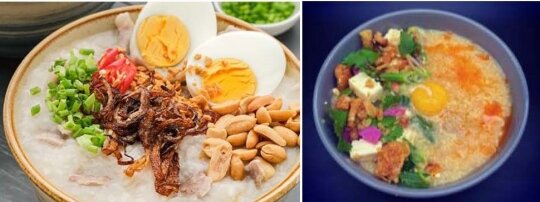 Left photo: Spicy pork lugaw with eggs and nuts; Right photo: female's favorite spicy lugaw with tofu and vegetables
Left photo: Spicy pork lugaw with eggs and nuts; Right photo: female's favorite spicy lugaw with tofu and vegetables
Malacanang Palace responded in resolving the issue, clarifying that “lugaw” and other food products are deemed important. “Rice porridge” or “lugaw” and/or any food products are considered essentials goods and their delivery should remain unhampered 24/7. Huwag nating harangan sa checkpoints. (Don’t bar this on checkpoints.) Presidential Spokesman Harry Roque said in a press statement.
The Philippine National Police (PNP) that all foods items that are “legitimately delivered,” including “lugaw” (rice porridge), are essential goods that should be allowed during the lockdown.
“The position of the PNP is that ANY KIND OF FOOD that are legitimately delivered upon orders by residents during the period of ECQ in the NCR Bubble is considered as part of essential goods,” the PNP said in a statement.
----------------------------
Writer’s Note : ( This article is dedicated to all “Kakampinks Worldwide” and all Filipino “Kababayans” around, globe so that everybody may know and be informed as to the humanitarian significance of “Rice Porridge” or “Lugaw” and, to attest to the truth and veracity of “lugaw” is not only a vital essential Philippine staple food, but a basic humanitarian food for survival during World War II. I invite you to please watch (HashtagAlliedforFreedom: Battle of Bataan and Liberation of Santo Tomas Internment Camp courtesy of the U.S. Embassy of the Philippines).
With Reports Written and Submitted By:
DOMINGO ‘DOMS’P. HERRAS
Corresponding Writer/Press Photojournalist
Sources : Malacanang Press Statement on the Resolution and Clarification
on Pandemic ECQ Lockdown Crisis posted on Facebook and Daily Newspapers
Facebook Posts on “Lugaw Controverssy”
Wikepedia on the Importance of “Rice Porridge”or “Lugaw”.
Researches from Press Releases
from various Daily Broadsheets on “Porridge/Lugaw”Controversy
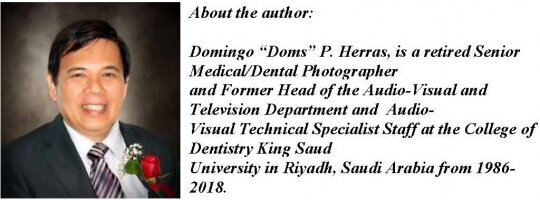
As a Freelance Writer and Press Photojournalist he writes and contributes news and feature articlesin the various foreign and local daily broadsheets, tabloid newspapers and online news magazines abroad. He is currently active member of the Federation of Philippine Photographers Foundation, Inc. (FPPF).
He is also an active regular member of the Press Photographers of the Philippines. He had recently completed the Reuters Journalism Digital Training Course and
awarded a Certificate of Completion by the Reuters Journalism Foundation.
